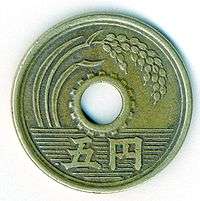5 sen coin
The 5 sen coin (五銭硬貨) was a Japanese coin worth one twentieth of a Japanese yen, as 100 sen equalled 1 yen.[1] These coins were minted from the late 19th century until the end of World War II. Like the other denominations of sen, these coins were eventually taken out of circulation at the end of 1953.[2] While not in circulation any more, these coins are bought and sold by numismatists for academic study, and by those with a hobby.
Japan | |
| Value | 1⁄20 Japanese Yen |
|---|---|
| Shape | Circular |
| Composition | Several different metals |
| Years of minting | 1870–1946 |
| Obverse | |
| Design | Various, depending on year. |
| Reverse | |
| Design | Various, depending on year. |
Composition
| Years | Material |
|---|---|
| 1870–1880[3][4] | 80% silver, 20% copper |
| 1889–1932[5][6] | 75% copper, 25% nickel |
| 1933–1938[7][6] | 100% nickel |
| 1938–1940[8][6] | 95% copper, 5% aluminium |
| 1940–1943[9][6] | 100% aluminium |
| 1944[10][6] | 93% tin, 7% zinc |
| 1945–1946[11][6] | 93% tin, 7% zinc |
Circulation figures
Meiji
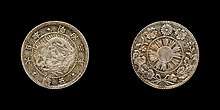
Design 1 - (1870–1871)
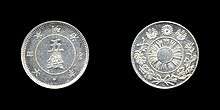
Design 2 - (1871)
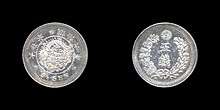
Design 3 - (1873–1880), (1892)[lower-alpha 1]

Design 4 - (1889–1897)
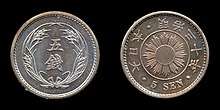
Design 5 - (1897–1906)
The following are circulation figures for five sen coins that were minted between the 3rd and 39th years of Emperor Meiji's reign. The dates all begin with the kanji characters 明治 (Meiji), followed by the year of his reign the coin was minted. Each coin is read clockwise from right to left, so in the example used below "四十二" would read as "year 24" or 1891.
- "Year" ← "Number representing year of reign" ← "Emperor's name" (Ex: 年 ← 四十二 ← 治明)
| Year of reign | Japanese date | Gregorian date | Mintage[6] |
|---|---|---|---|
| 3rd | 三 | 1870[lower-alpha 2] | 1,501,473[12] |
| 4th | 四 | 1871 (First design) | Unknown[12] |
| 4th | 四 | 1871 | 1,665,613[13] |
| 6th | 六 | 1873 TY1[lower-alpha 3] | 5,593,172[3] |
| 6th | 六 | 1873 TY2[lower-alpha 4] | |
| 7th | 七 | 1874 | 7,806,493[3] |
| 8th | 八 | 1875 TY3[lower-alpha 5] | 6,396,784[3] |
| 8th | 八 | 1875 TY4[lower-alpha 6] | |
| 9th | 九 | 1876[lower-alpha 7] | 5,546,424[3] |
| 10th | 十 | 1877 TY1 | 22,024,167[3] |
| 10th | 十 | 1877 TY2[lower-alpha 8] | |
| 13th | 三十 | 1880 | 79[3] |
| 22nd | 二十二 | 1889 | 28,841,944[15] |
| 24th | 四十二 | 1891 | 15,924,782[15] |
| 25th | 五十二 | 1892 (Silver) | Not circulated[3] |
| 25th | 五十二 | 1892 (Copper-Nickel) | 9,510,289[15] |
| 26th | 六十二 | 1893 | 8,531,858[15] |
| 27th | 七十二 | 1894 | 14,680,000[15] |
| 28th | 八十二 | 1895 | 1,030,000[15] |
| 29th | 九十二 | 1896 | 5,119,988[15] |
| 30th | 十三 | 1897 (Old design) | 7,857,669[15] |
| 30th | 十三 | 1897 (New design) | 4,167,020[15] |
| 31st | 一十三 | 1898 | 18,197,271[16] |
| 32nd | 二十三 | 1899 | 10,658,052[16] |
| 33rd | 三十三 | 1900 | 2,426,632[16] |
| 34th | 四十三 | 1901 | 7,124,824 |
| 35th | 五十三 | 1902 | 24,478,544 |
| 36th | 六十三 | 1903 | 372,000 |
| 37th | 七十三 | 1904 | 1,628,000 |
| 38th | 八十三 | 1905 | 6,000,000 |
| 39th | 九十三 | 1906 | Not circulated |
Taishō
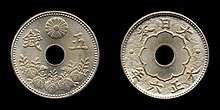
The following are circulation figures for five sen coins that were minted between the 6th and 12th year of Emperor Taishō's reign. The dates all begin with the kanji characters 大正 (Taishō), followed by the year of his reign the coin was minted. Each coin is read clockwise from right to left, so in the example used below "二十" would read as "year 12" or 1923. There are two types of varieties for year 9 (1920) coins that relate to a reduction in size and weight. The design of the coin did not change.[6]
- "Year" ← "Number representing year of reign" ← "Emperor's name" (Ex: 年 ← 二十 ← 正大)
| Year of reign | Japanese date | Gregorian date | Mintage[6] |
|---|---|---|---|
| 6th | 六 | 1917 | 6,781,830 |
| 7th | 七 | 1918 | 9,131,201 |
| 8th | 八 | 1919 | 44,980,633 |
| 9th | 九 | 1920 | 21,906,326 |
| 9th | 九 | 1920 (Reduced size) | 100,455,537 |
| 10th | 十 | 1921 | 133,020,000 |
| 11th | 一十 | 1922 | 163,980,000 |
| 12th | 二十 | 1923 | 80,000,000 |
Shōwa
The following are circulation figures for five sen coins that were minted between the 7th and 21st years of Emperor Shōwa's reign. The dates all begin with the Japanese kanji characters 昭和 (Shōwa), followed by the year of his reign the coin was minted. Each coin is read clockwise from right to left, so in the example used below "二十" would read as "year 12" or 1937. Some of the mintages included cover more than one coin variety for a given year, the base metals are included for easier identification. Coin patterns that include examples struck on porcelain are not included here as they were never issued for circulation. It is unknown how many unofficial locally made clay baked coins circulated.
- "Year" ← "Number representing year of reign" ← "Emperors name" (Ex: 年 ← 二十 ← 和昭)
| Year of reign | Japanese date | Gregorian date | Mintage[6] |
|---|---|---|---|
| 7th | 七 | 1932 (Copper-nickel) | 8,000,394 |
| 8th | 八 | 1933 (Nickel) | 16,150,808 |
| 9th | 九 | 1934 | 33,851,607 |
| 10th | 十 | 1935 | 13,680,677 |
| 11th | 一十 | 1936 | 36,321,796 |
| 12th | 二十 | 1937 | 44,402,201 |
| 13th | 三十 | 1938 TY1 (Nickel) | 10,000,000[lower-alpha 9] |
| 13th | 三十 | 1938 TY2 (Bronze) | 90,001,977 |
| 14th | 四十 | 1939 | 97,903,873 |
| 15th | 五十 | 1940 TY1 (Bronze) | 34,501,216 |
| 15th | 五十 | 1940 TY2 (Aluminium) | 167,638,000 |
| 16th | 六十 | 1941 | 242,361,000 |
| 16th | 六十 | 1941 (Reduced Weight) | 478,023,877 |
| 17th | 七十 | 1942 | |
| 18th | 八十 | 1943 | 276,493,742 |
| 19th | 九十 | 1944 (Tin) | 70,000,000 |
| 20th | 十二 | 1945 | 180,000,000 |
| 21st | 一十二 | 1946 |
Shōwa era designs
Five different designs were used during the Shōwa era for the 5 sen coin, not including pattern coins which were never intended for circulation. As the weight and sizes were changed frequently after 1940, these designs have been listed separate with their respective information.
| Image | Minted | Size | Weight | Comments |
|---|---|---|---|---|
 |
1932 (Year 7) |
19.1mm | 2.63 g | This was a one year type design that is similar to the following one. |
 |
1933-1938 (Year 8-12) |
19.0mm | 2.80 g | Only four 1938 dated nickel coins are known to exist.[17] |
 |
1938-1940 (Year 13-15) |
19.0mm | 2.80 g | The alloy was changed in 1938 to Aluminium bronze. |
 |
1940-1941 (Year 15-16) |
19.0mm | 1.20 g[14] | The alloy was changed in 1940 to Aluminium. |
 |
1941-1942 (Year 16-17) |
19.0mm | 1.00 g[14] | Reduced weight, both years have a combined mintage total. |
 |
1943 (Year 18) |
19.0mm | 0.80 g[14] | Reduced weight. |
 |
1944 (Year 19) |
17.0mm | 1.95 g | Reduced size, alloy changed to Tin/Zinc. |
 |
1945-1946 (Year 20-21) |
17.0mm | 2.00 g | Final issue of the series. |
Notes
- Coins dated 1892 of the 3rd design were made of silver but not circulated.
- Two varieties were made in 1870 in regards to the depth of the dragon's scales. The mintage figure shown is for the "shallow scales" variety, it is unknown how many were made for the "deep scales" coin.
- Coins dated 1873 will normally show the character 明 in Meiji's name separated. This was the first year in which the 3rd design for the 5 sen coin under Meiji was adopted.[14]
- The second variety of 1873 has the character 明 in Meiji's name joined via an extra stroke. Another name for this is the "connected" variety.[14]
- The reverse of 1875 TY 3 has the character sen (銭) with a pointed stroke.[14]
- 1875 "Type 4" coins were made with a "blunt stroke" on the sen (銭) character. These are scarce when compared to normal "Type 3" coins.[14]
- NGC lists at least 5 different combinations for coins dated 1876 using the 4 different types described above. The rarest of these is the "Type 2" obverse joined to the "Type 4" reverse (connected character in Meiji with blunt stroke in sen).[14]
- Coins dated 1877 have two different varieties again involving the character 明 in Meiji's name. Neither of these varieties have connecting characters, rather a horizontal stroke is missing in the 2nd type.[14]
- Almost the entire mintage of 1938 nickel alloy coins were melted.[17]
References
- "Japan 5, 10, 20, 50 Sen and 1 Yen (Fakes are possible) 1873 to 1900". www.coinquest.com. Archived from the original on October 4, 2011. Retrieved August 30, 2016.
- "小額通貨の整理及び支払金の端数計算に関する法律" [A law of the abolition of currencies in a small denomination and rounding off a fraction, July 15, 1953 Law No.60]. www.shugiin.go.jp. Archived from the original on June 28, 2002. Retrieved December 5, 2016.
- "Japan 5 Sen Yr.10(1877)-Yr.9(1876)". Numismatic Guaranty Corporation. Retrieved April 7, 2017.
- "5銭銀貨" (in Japanese). www.buntetsu.net. Retrieved April 7, 2017.
- "5銭白銅貨" (in Japanese). www.buntetsu.net. Retrieved April 7, 2017.
- Chester L. Krause & Clifford Mishler. Collecting World Coins 10th edition. Krause Publications. p. 430.
- "5銭ニッケル貨" (in Japanese). www.buntetsu.net. Retrieved April 7, 2017.
- "5銭アルミニウム青銅貨" (in Japanese). www.buntetsu.net. Retrieved April 7, 2017.
- "5銭アルミニウム貨" (in Japanese). www.buntetsu.net. Retrieved April 7, 2017.
- "5銭錫貨(2)" (in Japanese). www.buntetsu.net. Retrieved April 7, 2017.
- "5銭錫貨(3)" (in Japanese). www.buntetsu.net. Retrieved April 7, 2017.
- "Japan 5 Sen Yr.3(1870)". Numismatic Guaranty Corporation. Retrieved February 25, 2019.
- "Japan 5 Sen Yr.4(1871)". Numismatic Guaranty Corporation. Retrieved April 7, 2017.
- "Japan, 1870-1950 5 Sen". Star City Homer. Retrieved February 25, 2019.
- "Japan 5 Sen Yr.22(1889)-Yr.30(1897)". Numismatic Guaranty Corporation. Retrieved April 7, 2017.
- "Japan 5 Sen Yr.30(1897)-Yr.39(1906)". Numismatic Guaranty Corporation. Retrieved April 7, 2017.
- "Yr.13(1938) 4 known Almost entire mintage remelted". Numismatic Guaranty Corporation. Retrieved February 25, 2019.
